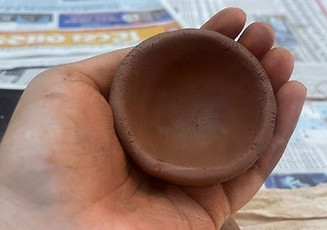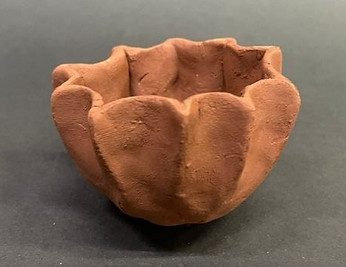Exploring material properties
Exploring the material possiblities and limitations using hand tools and understanding material behaviour and its appropriate application.
Leather
Exploring through punching, braiding, splitting, cutting, burning and culminating properties in a composition
Tools and material used
Calf leather
Mallet
Cutter

Punches
Stencil
Properties explored








FLEXIBILITY

Cutting the leather piece and making it more flexible, and stitching it to give it a 3D form
Metal
Exploring the simulating the effect of a force on an alminium metal sheet and wire.
MS metal wire


MS metal sheet
Tools and material used
Nose plier
Metal furnace
Metal shear (scissors)
Plier






Aluminium sheet
Hammer


Chisel
Filer
Exploring

Shaping, hammering, spot welding ms metal wire

Malleability and Springy
Hammering the ms metal sheet into a curve, cut the corners and shaping it into a bowl and spot welding the coiled ms metal wire onto the bowl and exploring the balance, modability, springiness in the form
Wood
Exploring both soft and hard wood, and exploring the extent of a particular property
Hax-saw
Tools and material used
Chisel
Filer
MDF
Soft wood

Hammer
Planner

Plywood
Hard wood
Exploring transparency




Light travel through different thickness of soft wood (pine), and not travel of life through hard wood (teak)
Flexibility


Balance

Cutting and shaping the marking on a wood block into curves on different faces of the bock. Its perfectly balanced with heavy weight on top and holding the form.
Textile
Exploring textile manipulation and its potential threough different properties.
Tools and material used
Scissors
Glue



Iron
Fabric

Stitching machine


Needle and thread
Exploring
Muslin fabric is soaked in fevicol and water mixture
Overlapping the fabric and making loops to insert the wire.
Removing threads weakens the fabric gives a clear view of warp and weft.




Using steam iron creating pleats and folds to the fabric

Stitching the fabric and pulling away the thread from one side gathers the fabric together.
Clay
Exploring terracotta clay as a material is to unlock its potential through hands-on experimentation.
Exploring



Diyas






Slabs

Learnings
-
Understanding material behavior: flexibility, strength, texture, and reaction to force.
-
Learning appropriate hand tools for each material and how to use them safely and effectively.
Leather -
Understanding grain direction, tanning processes, and thickness.
-
Learning how leather reacts to moisture, pressure, and heat.
Clay: -
Techniques like coiling, pinching, slab-building, and throwing.
-
Understanding plasticity, drying times, and firing.
Textile: -
Basic stitching, embroidery, weaving, and fabric manipulation.
-
Understanding different fiber types
Wood: -
Recognizing wood grain, types (soft vs. hard wood), and directionality.
-
Learning about moisture impact, and strength.
Metal: -
Hammering, bending, cutting, and joining (like riveting or soldering).
-
Understanding different metal types and their malleability